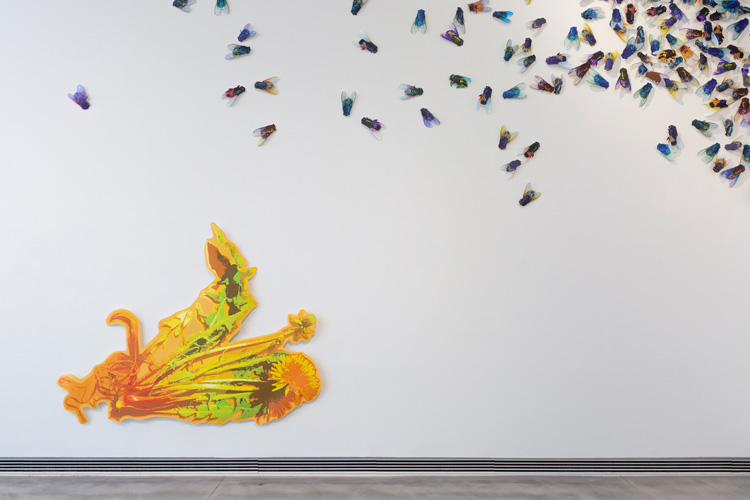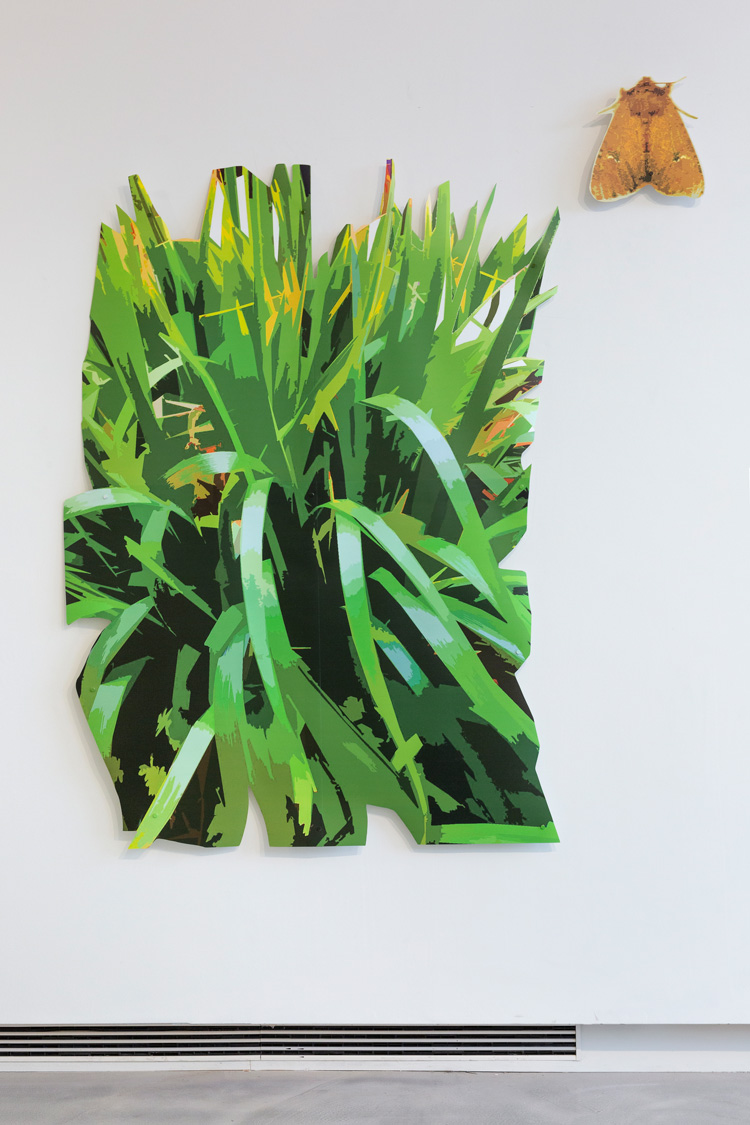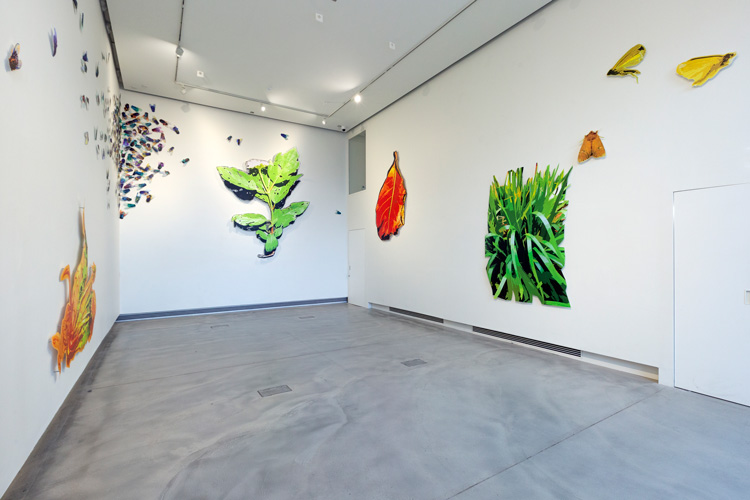
Alexandra Haeseker: The Botanist’s Daughter. Installation view, Edinburgh Printmakers, 2020. Photo: Alix MacIntosh.
Edinburgh Printmakers
18 January – 22 March 2020
by CHRISTIANA SPENS
In the latest exhibition at the recently reopened Edinburgh Printmakers, giant dead flies and fluorescent green weeds take over the gallery walls, drawing visitors into an eerie, threatening, and yet somehow moving, space in which our relationship to the natural world is problematised and explored.
The print works in this first solo UK exhibition of the Dutch-Canadian artist Alexandra Haeseker take inspiration from the hand-pulled engravings of insects and plants that are traditionally used to illustrate botanical and entomological resources for scientists. Reframing and reprinting these images, Haeseker brings into focus issues surrounding climate change and the human perception of it. She encourages us to question the assumptions we have about the natural world based on our own animal instincts about threat and survival. What are our natural instincts? Are they working against us, now? What should our natural instincts be when it comes to climate change?

Alexandra Haeseker: The Botanist’s Daughter. Installation view, Edinburgh Printmakers, 2020. Photo: Alix MacIntosh.
When I walk into the exhibition, the first image I fix on is that of a wilted dandelion, printed in garish green and yellow, and pinned to the centre of one of the gallery walls. Although this image is near perhaps a hundred giant flies, the dandelion, to me, seems the most anxiety-inducing. The artist and her partner are in the room, and we talk about the relative sense of anxiety or threat that these things inspired. “I would have thought that the flies would worry me more,” I say, “but in a way they are quite beautiful, in their shades of purple and blue. But the dandelion is threatening, even though it is just a weed.”
We talk about climate change – the bushfires in their country, Canada, and my birthplace, Australia, and the loss of wildlife. At this point, I realise that the flies on the wall are dead. “They are,” Haeseker says. “And you’re the first one to notice that.” Perhaps the flies are poignant rather than threatening because they are dead. As Haeseker goes on to say, we rely on insects for our existence – the world requires these tiny creatures to function properly – and the loss of them should threaten us more than the irritation or perceived dirtiness of a handful of them.

Alexandra Haeseker: The Botanist’s Daughter. Installation view, Edinburgh Printmakers, 2020. Photo: Alix MacIntosh.
The fluorescent weeds, too, imply toxicity, with their luminous green and yellow shades. Perhaps there is some natural human instinct that does recognise the danger of this off-balance ecosystem, even if it takes a closer focus to realise the implications of these senses. In these ways, then, The Botanist’s Daughter succeeds in reframing our relationship with nature and highlighting the fragility of the life forms we often take for granted, along with our own, in our inherent reliance on them to exist.
This is a humbling show: in this space, humans are not bigger than the creatures and plants we tend to trample on. Instead, we see the consequences of human existence on the very species we need to live. We feel, instinctively, before we quite understand the reasons underpinning this sense, that something is not right. Although it is not immediately obvious that the flies are dead, I am overcome by a wave of sadness, and so look closer. Although I don’t know why a dandelion should worry me, it does so, before I understand that it is somehow contaminated.

Alexandra Haeseker: The Botanist’s Daughter. Installation view, Edinburgh Printmakers, 2020. Photo: Alix MacIntosh.
Having grown up in the countryside, in the woods, among trees, insects and weeds, perhaps I am still quite finely tuned to these imbalances and changes. But I would hope that most people would come into this exhibition and sense, before they fully know why, that there is something off here, as there is something off in the wider natural world around us.
As Haeseker explains: “My studio work in the past decade has entered into the realms of where art and science meet. For The Botanist’s Daughter, I have produced subjective imagery at a scale that invites consideration of the parallel world that has always been present alongside our own. This exhibition looks deeper into what is often invisible to our eyes, below our feet, to consider how small changes can have larger consequences.”
In a striking and original way, Haeseker shows us how we rely on small things, and how their destruction can have huge and irreversible consequences. Indeed, they are not just “small things” – that is precisely her point. They matter as much as if they were six feet tall. Nature is bigger than us, even if we do not typically view it as such.
Haesker says: “My imagery might remind the viewer – in how the subject matter is oversized, mounted to the wall, and absolutely still – of extinct species we can only see in natural history museums around the world. And that is a sobering realisation, if within our lifetimes, we could observe the demise of bees, or certain flowering plants – the very things that make up our diversified world that are to a degree invisible to us, unless we look closer.”
Haeseker uses her art elegantly and boldly to communicate what really does threaten us – not phobias, not insects, but the demise of the “little things” in the natural world, on account of us thinking we are bigger and more powerful, more immune to destruction, than we really are.